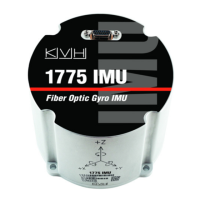This document contains proprietary information of KVH Industries, Inc. and neither this document nor said proprietary information shall be
published, reproduced, copied, disclosed, or used for any purpose without the express written permission of a duly authorized KVH
representative.
8.1.3 Response
AXES,[X
0
],[X
1
],[X
2
],[Y
0
],[Y
1
],[Y
2
],[Z
0
],[Z
1
],[Z
2
]
[X
0-0
],[Y
0-1
],[Z
0-2
] are floating-point values typically in exponential notation.
Response to above (default) would be:
AXES,+1.000000E+00,+0.000000E+00,+0.000000E+00,+0.000000E+00,+1.000000E+00,+0.000000E
+00,+0.000000E+00,+0.000000E+00,+1.000000E+00
8.2 ?axes
8.2.1 Description
This command queries the user-configured alignment axes relative to the true physical
orientation of the measurement axes.
8.2.2 Usage
?AXES
8.2.3 Response
AXES,[X
0
],[X
1
],[X
2
],[Y
0
],[Y
1
],[Y
2
],[Z
0
],[Z
1
],[Z
2
]
[X
0-0
],[Y
0-1
],[Z
0-2
] are floating-point values typically in exponential notation and define a 3x3
rotation matrix as described in the =AXES command.
8.3 =baud
8.3.1 Description
This command sets the baud rate of the system. Not all baud rates are usable at all data rates.
For instance, selecting a baud rate of 57600 with a data rate of 1000 Hz would not work,
because the full output data packet cannot be transmitted in 1 ms at that baud rate. Therefore,
care must be taken when using non-default data rate and baud rate combinations, or the IMU
will be unreliable. (See the data rate (=DR) command and information in Section 9.)
Baud is defaulted by the Config-RST signal assertion on power on/reset or else the baud set
with this command is persistent.
8.3.2 Usage
=BAUD,<9600|19200|38400|57600|115200|460800|576000|921600|4147200>
The integer value for baud is in Bd units and must be one of the acceptable values above.
8.3.3 Response
BAUD,<9600|19200|38400|57600|115200|460800|576000|921600|4147200>
Response will be at the new baud rate. Depending on software revision, the response may or
may not include the new value as a parameter.

